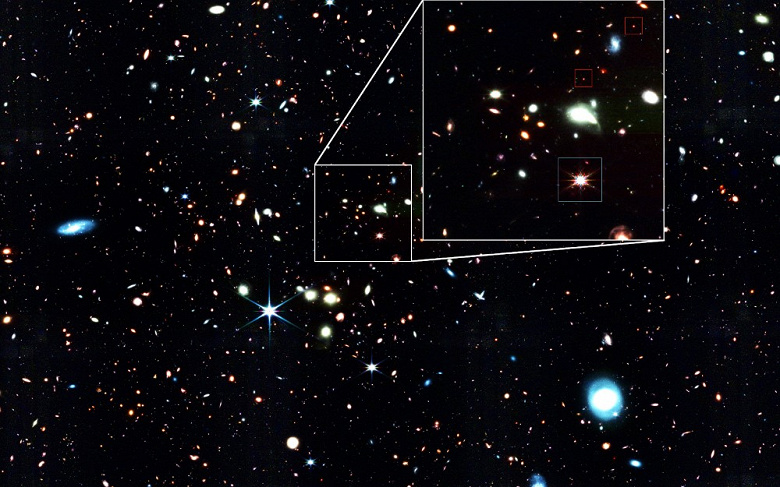“Little red dots” turned out to be an unusual class of objects
In the first year of operation of the «James Webb Space Telescope» (JWST) several significant discoveries were made. Among them — providing the clearest images yet of iconic cosmic structures such as the Pillars of Creation, transmission spectra of exoplanet atmospheres and views of Jupiter, its largest moons, the rings of Saturn, its largest moon Titan, and the plumes of Enceladus. However, JWST also made an unexpected discovery during its first year of observations that may prove to be a breakthrough: it discovered a group of «little red dots» in a tiny region of the Universe.
These objects were noticed during the EIGER («Galaxies with Emission Lines and Intergalactic Gas in the Epoch of Reionization») and FRESCO (&Laquo;Spectroscopically Complete Observations in the First Epoch of Reionization») surveys. According to a new analysis by an international team of astrophysicists, these points turned out to be galactic nuclei containing precursors to the supermassive black holes that existed in the early Universe. The existence of these black holes shortly after the Big Bang may change our understanding of the formation of the first supermassive black holes in the Universe.
The international team's research was led by Jorrit Matti, associate professor of astrophysics at the Austrian Institute of Science and Technology (ISTA) and the Swiss Technical School (ETH Zürich).
Scientists have long known that supermassive black holes are found at the centers of most massive galaxies. And while some are dormant, like Sagittarius A* at the center of the Milky Way, other black holes are active and growing at the rate of several solar masses per year. These rapidly growing black holes feed active galactic nuclei — quasars, which with their brilliance temporarily outshine all the stars in their disk.
Quasars are among the brightest objects known to astronomers. In recent years, astronomers have discovered several quasars and supermassive black holes in the early Universe, whose sizes exceed the predictions of cosmological models. As Matti explained in a press release: “One of the problems with quasars is the fact that some of them appear too massive relative to the age of the universe in which they are observed.” If we consider that quasars arise from the explosions of massive stars and that we have a maximum known rate of growth by general laws, then some of them look like they grew faster than possible. It's like looking at a five-year-old child who is two meters tall. Something doesn't add up.
Mathy and his team identified the population of “little red dots” by analyzing data from the EIGER and FRESCO studies in which Mathy was involved. The EIGER campaign was set up to search for rare blue supermassive quasars and their surroundings, not quasars in the early Universe. However, the Near Infrared Camera (NIRCam) is capable of recording the emission spectra of all objects in the known Universe. Previously, these objects were erroneously classified as ordinary galaxies, according to the results of observations by Hubble.
However, thanks to NIRCam, the team identified them as supermassive black holes. According to Mathy, this discovery could have profound implications for astronomy and cosmology: “JWST has helped us determine that these “little red dots” found in the distant past of the Universe are small versions of extremely massive black holes . These objects could change our understanding of the origin of black holes. These discoveries could bring us closer to answering one of astronomy's biggest mysteries: Some supermassive black holes in the early Universe grew “too fast,” according to current models. How they were formed?»
The team was able to distinguish galaxies from small quasars thanks to NIRCam detection of hydrogen spectral lines. They found that the observed spectra had a broad profile, which they used to determine the movement of hot hydrogen gas. «These spectra tell us that we are looking at a very small gas cloud that is moving at extremely high speeds and orbiting something very massive»,— Mathie said.
Equally important are the obtained redshift values, indicating that these objects existed more than 12 billion years ago — approximately 1 billion years after the Big Bang and were not as massive as those quasars observed today in neighboring galaxies. As Mathy noted: “These objects look like “quasar embryos.” Their mass ranges from ten to one hundred million solar masses. They appear red because they are "dusty". Dust darkens black holes and gives them a red color.
Eventually, a stream of hydrogen gas will penetrate the clouds of dust and gas surrounding and obscuring massive black holes (“dust cocoon”), and these smaller supermassive black holes will develop into larger ones. So Mathy and his team hypothesized that the «little red dots» are small red versions of giant blue supermassive black holes in the pre-“fancy quasar” stage. Subsequent observations by astronomers will allow more detailed studies of these young supermassive black holes, which may lead to a better understanding of the formation process of «problem quasars».

